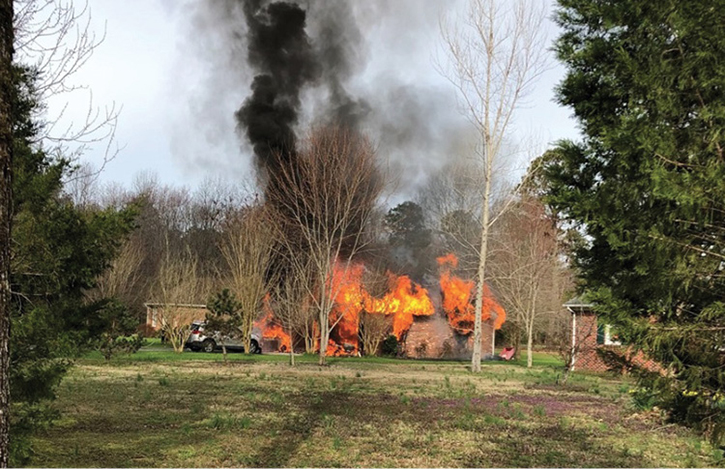
FIRE FOCUS ❘ By MICHAEL J. BARAKEY
On March 11, 2019, Suffolk (VA) Fire & Rescue (SFR) was presented with a routine fire that quickly became anything but routine. A Mayday was transmitted soon after firefighting operations were initiated at a residential structure. The incident was a “bread and butter” operation that, in an instant, challenged the firefighters and officers operating at the incident, the incident commander (IC), and the rapid intervention team (RIT).
The Call
The fire occurred in a “transitional” section of the city where “suburbia” merges with a rooted and established rural community. Two structures were on fire: a main residence and its detached garage. The structures were more than 100 feet off a narrow street that spurs off a main roadway and connects the rapidly growing suburbia with homes that are situated on large lots with extended driveways. The closest fire hydrant to the burning structures was at the intersection of the main road and the narrow rural street. The rural street is five miles long, so a tanker task force is integrated in the response matrix to provide water.

(1) Medic 9 and Engine 9 arrive on scene. (Photos by author unless otherwise noted.)
Heavy fire was showing on the roof and from the Charlie (C) and Delta (D) sides of the detached garage, light smoke and fire were showing from the Alpha/Bravo (A/B) corner of the main residence, and two vehicles were on fire in front of the detached garage (photo 1). The hydrant was 1,000 feet from the front driveway of the fire buildings, allowing responders to use the hydrant for the water supply instead of the tankers. The construction of the residence and garage was conventional Type V wood frame built in 1973. The main residence was a 2,580-square-foot ranch, and the detached garage was 1,000 square feet and on the D side of the home.
The main residence and the garage had hipped roofs with conventional composite shingles as the roofing and brick veneer covered the exterior walls. The garage was a 1½-story structure with two single-car garage doors on the A side and windows on the B, C, and D sides with a 36-inch residential door in the middle of the B side facing the main residence. Spanning the B and D walls in the garage, just below the exposed rafters that supported the hip roof, was a 25-foot steel I-beam. This I-beam was in the middle of the garage, just above the residential door on the B side.
The Response
At 0927 hours, Battalion 2; Engines 9, 6, and 4; Ladder 6; Rescue 1; Tankers 9 and 1; Medic 9; Safety 1; and EMS 1 were dispatched to a reported garage fire threatening a residence. While they were en route, a large column of black smoke was visible from fire headquarters. At 0933 hours, Medic 9 arrived and reported a large detached garage well involved with the house and two vehicles also on fire. Knowing Engine 9 was stopped down the street and recognizing the street was narrow with limited access to the front of the structure, Medic 9 parked in the driveway of the D exposure and established “command.”
Engine 9 stopped at the hydrant and considered laying in. The decision to drop or not drop a supply line was based on the Engine 9 lieutenant’s estimation of the distance of the fire from the hydrant. With heavy smoke visible from the hydrant and being unable to determine how far down the narrow road the fire was, the lieutenant decided to progress to the fire and relay back to the responding units if tanker operations would be necessary or if a supply line and the hydrant was feasible. Medic 9’s crew immediately identified two occupants in the front of the structure who confirmed everyone was out of the structure and then performed a 360° size-up of the garage and residence.
Once in front of the burning structures, Engine 9’s lieutenant advised the incoming units that the second-in engine would not likely make a lay from the hydrant to the attack engine because it appeared to be more than 1,000 feet long. After transmitting this information, the lieutenant assumed command and pulled the garden lay (using the Cleveland load) because of the distance from the attack engine and the burning structures. The attack line was a 1¾ inch off the gated wye from the 2½-inch leader line. The goal of the attack line was to protect the unburned portion of the exposure (the main residence) that was on fire and only feet from the well-involved garage and vehicles.
On completion of a walk-around, the lieutenant confirmed to incoming units that the main residence was on fire with fire advancing into the attic through the soffit and through two windows that had failed on the D side of the residence (photo 2). Stopping the advancement of fire into the main residence and then entering the garage through the door on the B side was the lieutenant’s tactic as the garage and the two vehicles were already heavily involved.
Battalion 3, responding from fire headquarters, arrived before Battalion 2 and assumed command from Engine 9’s lieutenant just as Engine 6 and Ladder 6 arrived. Battalion 3 remained in command and Battalion 2 became Operations on arrival.

(2) A walk-around of the garage showed heavy fire from the rear windows on the C side.
While en route, Engine 6’s officer was using aerial global positioning information to identify the distance of the fire from the main road and hydrant and felt his crew could complete the lay from the hydrant. He directed his operator to wrap the hydrant and forward lay into Engine 9. Understanding Engine 9’s transmission that the lay appeared to be longer than the amount of hose carried in the hosebed, command directed Engine 6’s officer to back down the road and lay out from Engine 9 to the hydrant. Already committed into the narrow rural street and blocking access for Ladder 6 and all incoming apparatus, Engine 6’s officer directed the operator to unwrap the hydrant and drive down the street so that the ladder, command, and all the additional apparatus could get close to the scene. Command then assigned water supply to the third engine, Engine 4, and that officer was directed to back down and lay out to the hydrant.
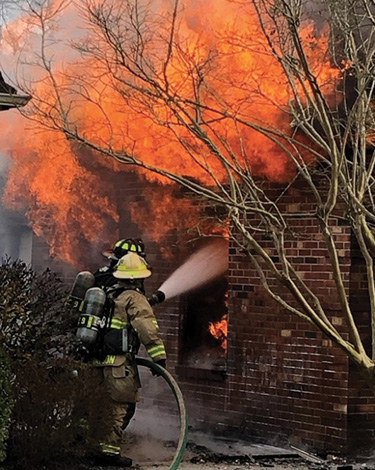
(3) The transitional attack on the garage through the B-side window.
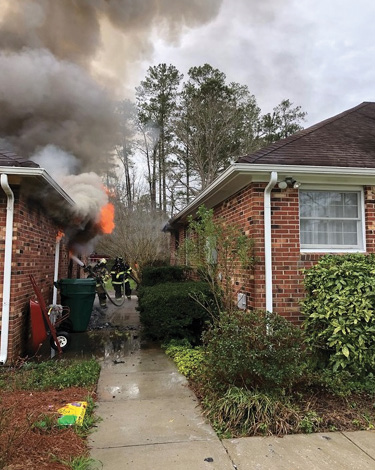
(4) Engine 9’s crew advances an attack line into the door on the B side of the garage just prior to the structural collapse.
While the water supply was being secured, Engine 9 operated the 1¾-inch handline in the breezeway that separated the garage from the residence. This was a tactical position for the attack line because the lieutenant was able to protect the main residence from additional fire damage because of the potential of direct flame impingement and the radiant heat from the large fire load from the garage and vehicles. Water from the attack line was immediately placed on the main residence, washing the soffit and windows that had failed.
Once the lieutenant felt crews had stopped the threat of additional fire from advancing on the main residence, she directed Engine 9’s firefighter to execute a transitional fire attack on the well-involved garage (photo 3). The attack was made through windows that had failed on the B side of the garage and the door beyond the windows as well as in the middle of the B side of the garage. The lieutenant felt the transitional attack was effective and planned to advance into the garage from the door on the B side of the garage.
The location of the transitional attack allowed the lieutenant to monitor fire conditions in the garage as well as the main residence. The attack was effective in protecting the main home, and the fire in the garage was concentrated to the A/D side and roof area. The transitional attack was working through the windows, so the lieutenant directed the firefighter to advance the attack line forward in the breezeway between the main home and the garage toward the door in the middle of the B side of the garage (photo 4). Fire conditions were not as advanced at this section of the garage, and access to the fire was unobstructed.
The lieutenant and firefighter made the door and operated the attack line in the doorway for several minutes. Sensing that fire conditions were not changing—even with an aggressive transitional attack—the lieutenant retreated the attack line to the corner of the garage and residence to continue the attack from the corner of the building.
While Engine 9’s crew worked the transitional attack, command directed Engine 6’s crew to place the second line into the main residence. Engine 6’s crew used their high-rise pack and hooked into the gated wye from Engine 9’s Cleveland load and used that line for interior operations in the house. After making entry, Engine 6’s crew reported light smoke conditions and checked the main house for fire spread and extension into the attic. The attic was clear, and fire was limited to the room on the D side of the house where the windows had failed. Ladder 6, once positioned as close to the structures as possible, was assigned RIT by the IC. Engine 4’s crew backed down to Engine 6, laid 800 feet of five-inch supply line to the hydrant, and used 200 feet of five-inch line from Engine 6 to complete the lay.
The Mayday
Engine 9’s lieutenant noticed that the transitional attack was not making any additional headway in the breezeway and the push on the fire in the personnel door on the B side was not effective, so she decided to reposition the crew and hoseline to the A/B corner of the garage and protect the main residence. During the retreat to the A/B corner, the lieutenant noticed the B-side wall of the garage moving and elected to get Engine 9’s firefighter “out of the way.” The firefighter was to the left of the lieutenant and, as the wall was shifting, the lieutenant “pushed” the firefighter to the front of the structure, away from the falling wall.
While Engine 9’s crew was retreating to the A/B corner of the garage, Ladder 6’s crew (the RIT) walked up to the structure. The crew had pulled the RIT handline off Engine 9 and was starting to gather the RIT equipment off Ladder 6. The RIT officer was beginning a 360° size-up when the wall collapsed. The RIT officer saw the wall collapsing from the front yard and yelled, “Wall, wall, wall.” The RIT officer then saw Engine 9’s lieutenant push the firefighter away from the collapsing wall just as the wall came down.
Noticing that the wall had landed on Engine 9’s lieutenant, the RIT officer went immediately to the collapsed garage to perform a rescue. The RIT officer observed the lieutenant’s torso hanging out of the debris of the fallen wall, and roof and brick were on top of her. Car 1, positioned in the front yard, declared the Mayday to the IC over the fireground channel while the RIT and the Engine 9 firefighter who was pushed away from the collapsing wall began to dig out the lieutenant who was trapped by the brick and fallen debris.
After the wall came down, the lieutenant did not have any recollection of the collapse until the RIT and the Engine 9 firefighter pulled her away from the collapsed area and debris. Command, on receiving the Mayday on the fireground channel, announced the Mayday. The dispatcher assigned to the fireground channel acknowledged the Mayday immediately and moved all companies not assigned to the rescue off the established fireground channel and to another tactical channel. The lieutenant was removed from the debris and pulled away from the hazard area to the front yard of the structure where the firefighter/medics on Medic 9 met the RIT and Rescue 1 firefighters with a stretcher and medical equipment. The lieutenant’s helmet and face piece were removed by the RIT officer, and she was assessed for injuries (photo 5).
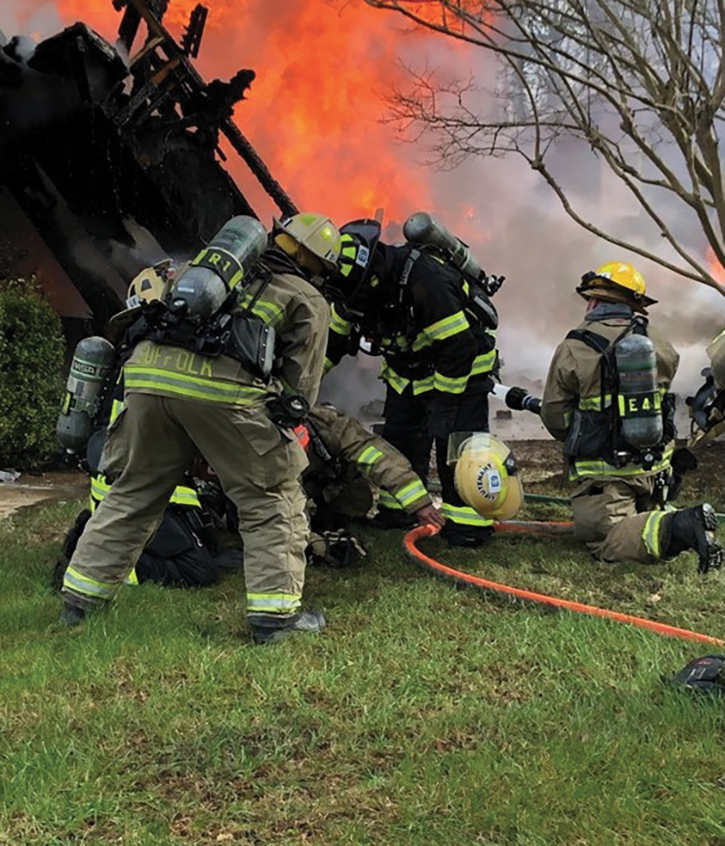
(5) The lieutenant is moved from the collapse to the yard for assessment and treatment.
While the lieutenant’s self-contained breathing apparatus (SCBA) and coat were being removed, it was apparent that she was injured in the left shoulder area, buttocks, and lower extremities. The lieutenant told the RIT, “My legs are on fire, I’m burning up, my legs are burning,” and complained of extreme pain in the shoulder and neck. During the lieutenant’s assessment, Engine 4’s crew used the RIT handline to protect the lieutenant and RIT from radiant heat. The medics removed the lieutenant’s turnout coat. The lieutenant’s helmet was scarred from the falling wall, and the SCBA bracket was destroyed and its bottle had dislodged from the bracket and was dangling. Medic 9 loaded the lieutenant on the stretcher and provided advanced life support care while the operator of Ladder 6 worked to build a ramp with step chocks over the supply line so that the medic could take the injured lieutenant to the hospital immediately after she was loaded.
While Engine 4’s crew protected the down lieutenant, the handline lost water. Engine 4’s operator established a water supply to the attack engine, which quickly restored water on three handlines. Defensive fire operations continued for the duration of the incident. The lieutenant suffered crush injuries to her upper body and legs and burns to her lower body; she will be out of work for a minimum of six months (photo 6). The firefighter operating with the lieutenant suffered arm and hand burns from removing debris off the lieutenant; the firefighter missed three shifts and is now back to full duty.
Once the fire was out, the fire investigators completed a detailed fire scene investigation to determine the cause and origin of the fire as well as the cause of the sudden collapse, which was found to be from the expansion of the steel I-beam that spanned the length of the middle of the garage. The fire marshal declared the cause of the fire undetermined.
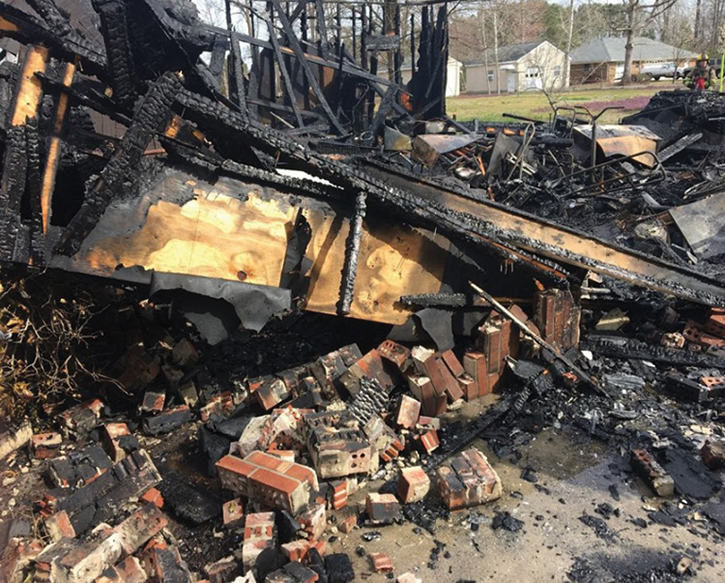
(6) The area of collapse from where the rapid intervention team and Engine 9’s firefighter removed the lieutenant. (Photo by Chris Balassone.)
Lessons Learned
Following are some lessons the SFR learned postincident:
- Establish command. Medic 9 established command and provided valuable information to incoming units. First-arriving units, regardless of the apparatus “type,” set the tone by performing a 360° size-up. Medic 9, staffed with two firefighter medics, provided an outstanding size-up of the burning structures and identified that all occupants were accounted for and out of the main home. It is everyone’s responsibility to be trained and prepared to perform scene and incident size-ups and establish command.
- Establish a water supply. Water supply in a transitional area of a city/county response area is challenging. Officers need to be proficient with mobile data terminals and handheld devices to determine the location and distance of hydrants to addresses and structures. At this incident, Engine 6’s lieutenant understood the need to establish a water supply while responding. Using technology and the city-issued map book, he felt Engine 6 could complete a forward lay and supply the attack engine. Command decided to change Engine 6’s officer’s plan to forward lay from the hydrant to the fire, yet the hydrant was already wrapped and the operator was preparing to drop the line. This change delayed water from being supplied to the attack engine. Because of the narrow road and seeing that Engine 6 was blocking access of Ladder 6 and additional units, the lieutenant followed the order of command; the operator unwrapped the five-inch from the hydrant and Engine 6 drove into the scene. Each officer understands his tactical role on the fireground based on training and policy. The Engine 6 officer had a plan to supply the attack engine and used the map book and technology to decide to lay the supply line. Receiving and executing orders are essential as well, yet a delay in water supply cannot occur with heavy fire conditions that threaten exposures. Although water supply was delayed here, it was completed by Engine 4, which backed down the narrow street and reverse-laid to the hydrant.
- Be prepared for rural operations. In rural areas, access is limited based on the road network and size. “Normal” traffic can hinder access and firefighting operations. Allowing vehicles and fleeing traffic to exit narrow rural roads will allow large fire apparatus to gain entry and closest access possible. When Engine 6 arrived at the hydrant, there was a citizen’s vehicle limiting access down the narrow street. The officer of Engine 6 recognized the citizen’s vehicle was blocking access and allowed the vehicle to move from the narrow road, thus allowing access to the hydrant and street. This decision allowed access for the remaining responding fire apparatus and medic units.
- Employ proper use of personal protective equipment (PPE). Proper PPE use protected the lieutenant and Engine 9’s firefighter from additional critical injuries. Every firefighter operating in or around the structure was wearing full PPE including SCBA. When the wall collapsed, the lieutenant’s helmet deflected the brick veneer wall and protected her from a head injury. The wall then struck the lieutenant’s left shoulder area, causing a crush injury to the upper body. The debris from the wall also caused bruising and burns to her lower body. The firefighter on Engine 9 who lifted and moved the debris off the trapped lieutenant suffered arm and hand burns from the heated debris. There is no time to put on PPE when a collapse occurs; the time from collapse to extrication was less than a minute only because the IC established a RIT early into the operation and the Engine 9 firefighter immediately removed debris off the lieutenant. Without properly sized gear that is maintained and inspected as well as the use of SCBA, the lieutenant’s and firefighter’s injuries would have been more critical. Proper use of PPE matters.
- The importance of critical decision making. The decision making of Engine 9’s lieutenant was experienced and wise. She made critical decisions to limit the spread of fire by reading the buildings and how the attack was progressing. Knowing fire behavior and the effects of decisions on the fire is an essential skill of prepared officers. Transitional attacks take skill, and officers must understand fire behavior when deciding where to execute the transitional attack. Just because an officer chooses a transitional attack does not mean the crew is any safer than with an interior attack.
- Recognizing collapse potential. Detached garage fires are often considered “bread and butter” fires. Residential structures are just as dangerous as any other fire and can collapse under extreme conditions. Firefighters are used to the fuel simply “burning” away at Type V residential structures. The expansion of the I-beam pushed out the B and D walls, causing a sudden collapse. Recognizing collapse zones around well-involved structures is important when working a transitional attack. At this incident, it was essential to work the A/B corner of the garage and to protect the main house and not to be inside the well-involved garage.
- Safety officer assessment and engagement with the IC. The IC had set up the command post several hundred yards away from the fire; this was the closest he could establish the command post based on the narrow rural street and the placement of the first-arriving engines and ladder. Without direct visualization of operations, the shift safety officer was the IC’s eyes on the fireground. The collapse occurred early into the incident, but the safety officer was on scene and just started performing a walk-around when the wall collapsed. All firegrounds need to assign a safety officer early on who should report back to command “big picture” items such as the percent of involvement of the structure, where the fire is going, time involvement, building construction concerns, the impact of fire on unique building construction, work times of crews, additional resources needed for safer work times/periods, and a face-to-face with the RIT to access concerns and where operations are hazardous.
MICHAEL J. BARAKEY (CFO) is a 26-year fire service veteran and the chief of Suffolk (VA) Fire & Rescue. He is also a hazmat specialist, an instructor III, a nationally registered paramedic, and a neonatal/pediatric critical care paramedic for the Children’s Hospital of the King’s Daughters in Norfolk, Virginia. Barakey is a task force leader for VA-TF2 US&R team and an exercise design/controller for Spec Rescue International. He has a master’s degree in public administration from Old Dominion University and graduated from the National Fire Academy’s Executive Fire Officer Program in 2009. Barakey authored Critical Decision Making: Point-To-Point Leadership in Fire and Emergency Services (Fire Engineering), regularly contributes to Fire Engineering, and is an FDIC International preconference and classroom instructor.

